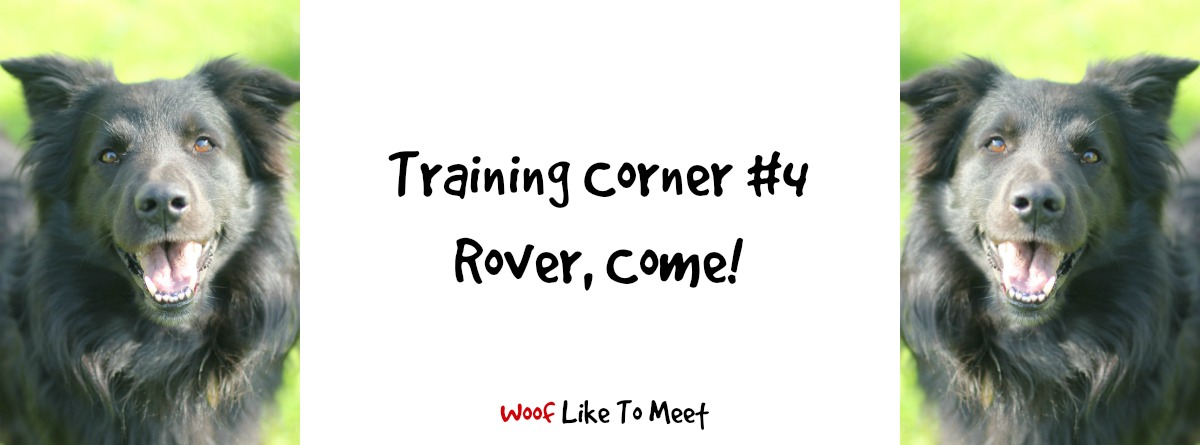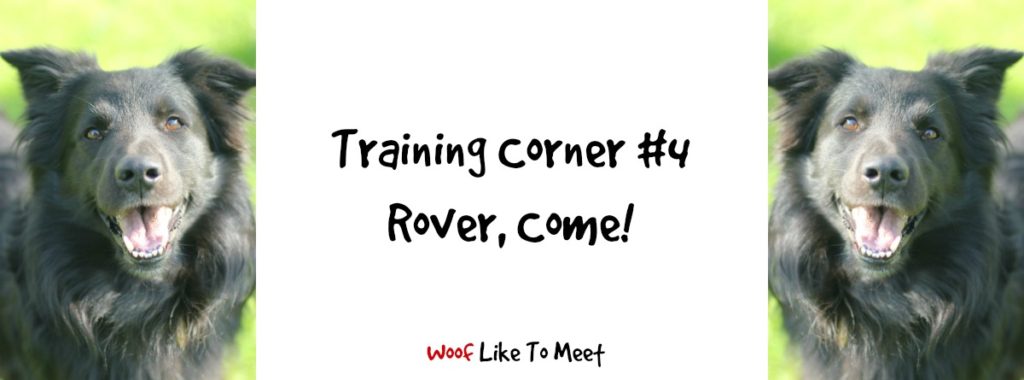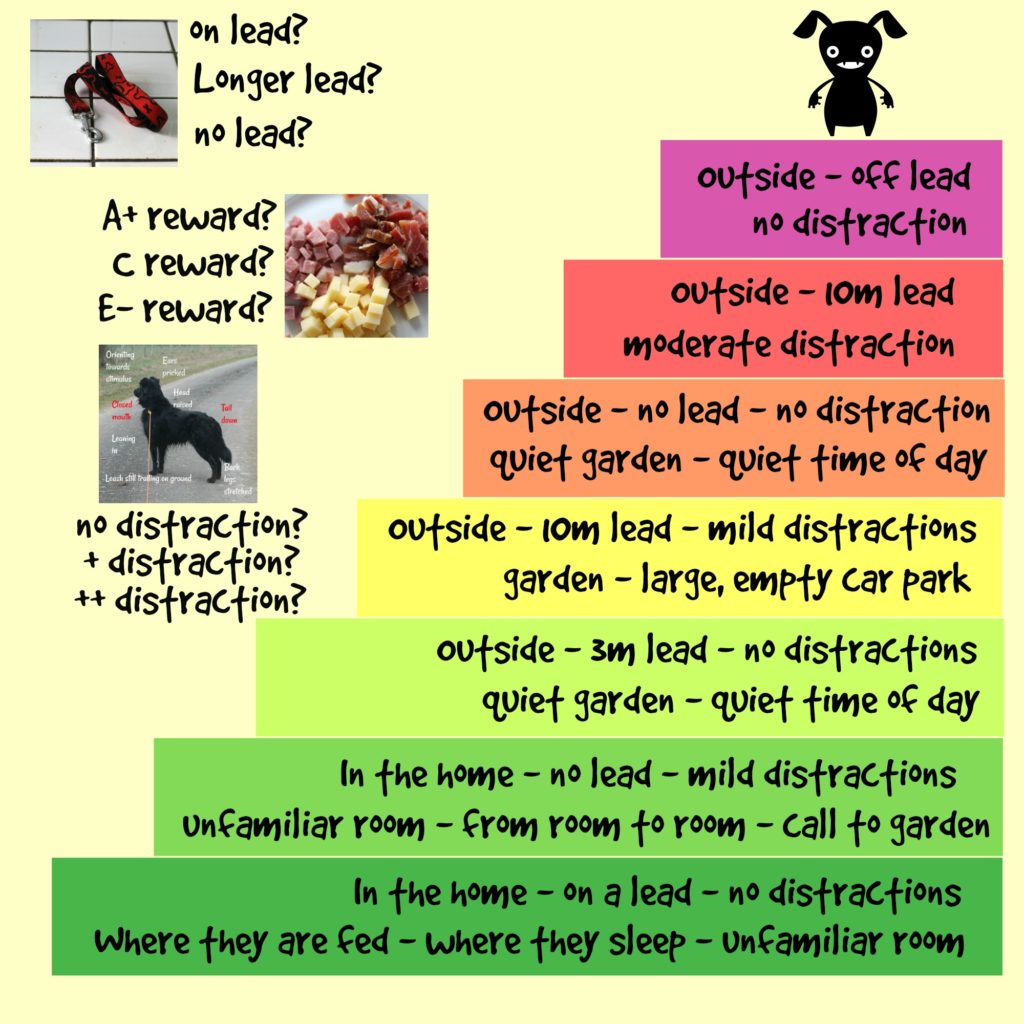Recall is one of those skills that is absolutely crucial. You might have thought that I’d have put it at number 1, and you’d have good reason to make that argument. But some of those things you’ve taught before can also help you with recall, giving you a range of ways to get your dog coming back to you.
A dog with an instinctive recall is a dog you can let off lead wherever you like. A dog with a rock-solid recall can enjoy the world around them and will not have to do such self-employed things like charging up to other dogs or people, or engaging in chase activities. They’re dogs you can have off-lead around other animals, around cars, around joggers, around cats and around a range of environmental stimuli.
All dogs have their own challenges where recall is concerned. Some of those behaviours are based in predation. They just love truffle-hunting. They enjoy rooting around in bushes. They love running. They love chasing. Something moves in the distance and they don’t care if it’s a car or a cow – they’ve just got to investigate. They have stuff and they don’t want you to have it. They have stuff and they don’t want other dogs to have it. They want to eat stuff or drink stuff. They want to wander off and roll in something foul.
Some of those behaviours are based in emotion: they’re fearful and they want to get away. They are lacking in confidence and they’re looking to hide. Some are based in fearful aggression: they want to create distance by charging up to strangers, shouting the odds at a strange dog or seeing off anything that crosses the boundary of their comfort zone. Some are based in joy: chasing, racing and rolling.
Recall behaviours are ones you can start to capture and encourage as soon as the puppies start moving independently. Imagine how much easier it is if your dog has already practised ‘Come!’ fifteen times a day in the four or five weeks until they get to you. That’d be over 500 practice goes that they already have under their belt!
But most of us leave it until they are older – nine or ten weeks at the least – and we miss out on all that valuable time. Not only that, it comes at a time when puppies want to explore the world and investigate.
And that’s what recall comes down to: You vs The Environment.
You can find other recall information on my post about poor recall that will help you with older dogs or in understanding in more detail. If you have a really, really challenging dog, you may also find Susan Garrett’s Recallers programme to be massively beneficial. Absolute Dogs have a programme that will also help. Other resources such as Leslie McDevitt’s Control Unleashed and Emily Larlham’s Harnessing the Hunter will also be a really good investment.
But I wanted to give you ten quick games you can play with your dog to help their recall. You will need to practise these in the home (on-lead and then off-lead) in the garden (also on-lead and off-lead), out in the environment (on-lead, on a long line, with a dropped long line, off-lead) and then in more challenging environments.
Recall can be repetitive and boring for us, and for our dogs. Finding ways to make coming back to us exciting makes it much more pleasurable and that means we’re much more likely to be effective.
The most important thing to bear in mind is challenge:
Start at the bottom and work to the top!
You might find some of this will need adapting. I know dogs who find their own garden massively overwhelming.
Don’t forget you can also play with:
Calm vs excitable
Distance FROM distraction vs Distance FROM you
All of the games that follow can be practised at different points on the Challenge Ladder. If it’s too hard, go back down a step. Try to make sure your dog doesn’t fail with recall. It only takes one super-pleasurable cat chase for your dog to learn that cat chasing is The Best Thing Ever Invented. Coming back? Yeah, not so much.
If you mess with one factor and make it more challenging, bring the others down again. Just because my dog’s recall is great off-lead in the house doesn’t mean that it will be in the garden, so put them back on a shorter lead, then a longer lead, then a dropped lead, then no-lead.
And you can mess with the rewards you use too. Food is only one. Toys, games, smells and behaviours are some others. Not amazing to find that the speed with which Miss Lidy-la-Louve was completing a hand touch was so much faster when cheese was involved rather than general kibble! Never a surprise that the squeak of Heston’s rugby ball will bring him back from a highly distracting environment. The best reinforcer on Heston’s recall? Disgusting… you’re going to hate me for making the most of this… my cocker spaniel’s pee. When Tilly pees, Heston comes back to have a sniff. But as a reinforcer for recall, it’s more reliable than his squeaky ball.
You’re going to need a good word – most people use ‘Come’, but you can also put your dog’s name in there. That is pretty useful if you want your dogs to be able to come when called and differentiate between ‘Doggies come!’ or ‘Tilly come!’ Vital in a multi-dog household! When you’ve got an ‘Amigo Stay – Tilly Stay – Heston Come’, you can easily split up your dogs without fuss. You won’t believe how useful a bilingual ‘come’ can be. ‘Viens!’ only works on my French fosters, not on my own English-speaking dogs. A gesture works with my deaf dog.
So… ten games. These are a mix from various recallers programmes, or programmes designed to get your dog’s focus on you.
- ‘Come’ to a whistle or other sound. Use the ladder and start at the bottom, pairing the sound with a top notch reward. One squeak of Heston’s toy and he’s there! Once they’ve mastered one sound, add another. You can’t beat having ten ways to get a dog to come back. ‘Does Tilly want a treat?’ works marvellously when Tilly looks like she might toddle off to find some lovely ripe cow pat to nosh on. Better than ‘Tilly, come!’. Likewise ‘Does Heston want a treat?’ is not as powerful as the whistle (which means tug) or a squeak of his toy.
- ‘Drop!’ – you’ve already got this one from last week. Use the ladder and work up.
- ‘Surprise!’ – treats rain from the skies all around you. Both 2 and 3 are really just variations on number 1.
- Jackpot recall – once in a while, give them an amazing, amazing payoff. Once I’ve phased out the rugby ball, I may just have it there once! For food-oriented dogs, paté, stinky cheese, a raw bone… For scent-oriented dogs, how about a sniff from a pot of stinky weasel poo? You laugh now, but I have a jar with a weasel poo in it.
- The Up-Down game. Drop a treat on the floor. When the dog looks up at you for the next, say ‘yes!’ or click and then drop the treat on the floor again.
- The ping-pong game. Throw a treat away from you. When the dog orients back to you, say ‘yes!’ or click, then throw the treat away from you.
- Touch target. Your dog should already be good at hand targeting if you’ve been doing this since Week 1. Games 1-7 can all be used with the ladder.
- Chase me! In a safe, enclosed environment, shout ‘Chase me!’ and run away! Play tig/chase with your dog and reward them ‘catching’ you with a game or another reward. Heston’s favourite reward for this is a bit of wrestling.
- Reward with a trick. If your dog already has another trick they like to perform, use it. Lidy loves to jump off my chest. I don’t let her do this very often as it is terrifying to have a mali-raptor up close and personal with your face, but when I say ‘hup!’ and pat my chest, she’s on it! Heston loves ‘bow!’ and will come running to perform it. It’s usually followed by the trick, ‘show me your wiener!’ and a tickle festival.
- Thigh pat recall. Pat your thigh, give a reward. Practice where your dog can see you and reward with something they like. I have paired thigh pat with a petting session.
When you have a range of gestures, words and sounds that mean ‘come here!’ and are paired very clearly with certain rewards, you can think about what the needs of your dog are at that time and use it accordingly. Amigo never fails to come for a thigh pat and it works well because he’s deaf. He loves petting sessions, no matter where we are. If Heston is in a silly mood, bowing, tickling and showing his wiener work. Squeaky noise trumps everything. Chase me! is great if he’s wanting to chase something. If I spot a hare he’s not seen yet, me shouting ‘Chase me!’ in the opposite direction gets him away from the blessed hare and gives him a behaviour I know he really likes.
One final word: don’t expect food to work all the time here. Not even liver paté. If you don’t have a range of amazing paired cues and a range of really valuable rewards, don’t expect to find your liver paté to trump a hare chase.
Unless you have a Tilly.
Then food trumps everything apart from rolling in fecal matter.
Recall is so very essential, and it’s the one thing we poison by following it up by ‘removal from fun’. If you want your dog to come back to you, having fifty ways to get it will help you.
And remember: sometimes it is just too hard. In those cases, don’t keep shouting! If it’s important that your dog comes when you call and you think they might not, put a lead on them!
Even the best recall and a dog who is usually your shadow can be thwarted by simple environmental factors like rain!
Aim to have a couple of calls, a couple of noises, a couple of toys, a couple of behaviours, a gesture and a couple of environmental factors up your sleeve, adding a new one in there every couple of weeks. You won’t weaken the behaviour by having a range of cues for it, I promise! Over time, you’ll come to see that in some circumstances, some recalls work better than others, and that you’ll have one or two that will be rock-solid despite everything.
But don’t expect 100% recall everywhere. Sometimes it’s just too hard. “Does Tilly want a treat?” will get Tilly out of the cow-pat she’s rolling in. If I’m not 100% sure it will, she’ll be on lead.



